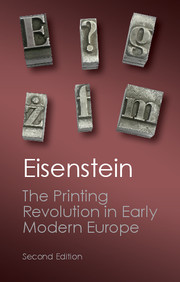Book contents
- Frontmatter
- Contents
- List of Illustrations and Maps
- Preface to the Second Edition
- Introduction
- THE PRINTING REVOLUTION IN EARLY MODERN EUROPE
- PART I THE EMERGENCE OF PRINT CULTURE IN THE WEST
- 1 An Unacknowledged Revolution
- 2 Defining the Initial Shift
- 3 Some Features of Print Culture
- 4 The Expanding Republic of Letters
- PART II INTERACTION WITH OTHER DEVELOPMENTS
- Afterword: Revisiting the Printing Revolution
- Selected Reading
- Index
4 - The Expanding Republic of Letters
from PART I - THE EMERGENCE OF PRINT CULTURE IN THE WEST
Published online by Cambridge University Press: 05 October 2013
- Frontmatter
- Contents
- List of Illustrations and Maps
- Preface to the Second Edition
- Introduction
- THE PRINTING REVOLUTION IN EARLY MODERN EUROPE
- PART I THE EMERGENCE OF PRINT CULTURE IN THE WEST
- 1 An Unacknowledged Revolution
- 2 Defining the Initial Shift
- 3 Some Features of Print Culture
- 4 The Expanding Republic of Letters
- PART II INTERACTION WITH OTHER DEVELOPMENTS
- Afterword: Revisiting the Printing Revolution
- Selected Reading
- Index
Summary
THE RISE OF THE READING PUBLIC
Given the religious, linguistic, and socioeconomic diversity of European readers, it is difficult to imagine just what figure Marshall McLuhan had in mind when he wrote about the “making of typographical man.” By making us more alert to the possibility that the advent of printing had social and psychological consequences, McLuhan performed, in my view at least, a valuable service. But he also glossed over multiple interactions that occurred under widely varying circumstances. Granted that the replacement of discourse by silent scanning, of face-to-face contacts by more impersonal interactions, probably did have important consequences; it follows that we need to think less metaphorically and abstractly, more historically and concretely, about the sorts of effects that were entailed and how different groups were affected. Even at first glance both issues appear to be very complex.
We will not pause for long over one complication that has recently attracted attention: namely, Paul Saenger's demonstration that habits of silent reading developed during the Middle Ages. It is now clear that McLuhan and the scholars upon whom he relied overstated the oral character of medieval interchanges and mistakenly assigned to printing responsibility for introducing habits of silent scanning which had already developed among some literate groups in the age of scribes. But although printing did not introduce silent reading, it did encourage an increasing recourse to “silent instructors, which nowadays carry farther than do public lectures” (in the words of a sixteenth-century professor of medicine).
- Type
- Chapter
- Information
- The Printing Revolution in Early Modern Europe , pp. 102 - 120Publisher: Cambridge University PressPrint publication year: 2012

